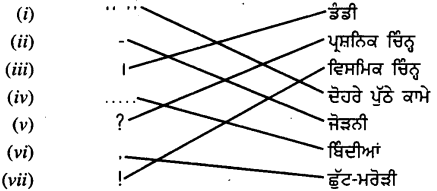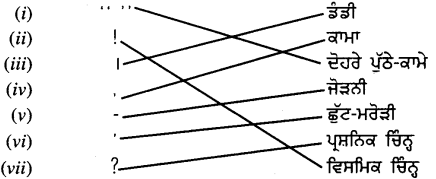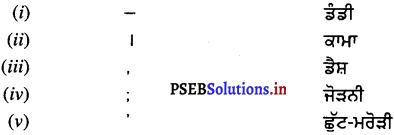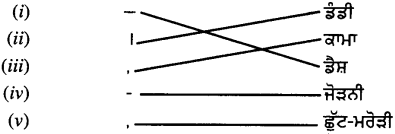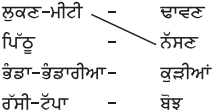Punjab State Board PSEB 7th Class Punjabi Book Solutions Chapter 14 ਕਰਤਾਰ ਸਿੰਘ ਸਰਾਭਾ Textbook Exercise Questions and Answers.
PSEB Solutions for Class 7 Punjabi Chapter 14 ਕਰਤਾਰ ਸਿੰਘ ਸਰਾਭਾ (1st Language)
Punjabi Guide for Class 7 PSEB ਕਰਤਾਰ ਸਿੰਘ ਸਰਾਭਾ) Textbook Questions and Answers
ਕਰਤਾਰ ਸਿੰਘ ਸਰਾਭਾ ਪਾਠ-ਅਭਿਆਸ
1. ਦੱਸੋ :
(ਉ) ਕਰਤਾਰ ਸਿੰਘ ਸਰਾਭਾ ਦੇ ਜਨਮ ਅਤੇ ਬਚਪਨ ਬਾਰੇ ਦੱਸੋ।
ਉੱਤਰ :
ਕਰਤਾਰ ਸਿੰਘ ਸਰਾਭੇ ਦਾ ਜਨਮ 1896 ਈ: ਵਿਚ ਸ: ਮੰਗਲ ਸਿੰਘ ਦੇ ਘਰ ਪਿੰਡ ਸਰਾਭਾ, ਜ਼ਿਲਾ ਲੁਧਿਆਣਾ ਵਿਚ ਹੋਇਆ। ਛੋਟੀ ਉਮਰ ਵਿਚ ਹੀ ਉਸ ਦੇ ਪਿਤਾ ਦਾ ਦੇਹਾਂਤ ਹੋ ਗਿਆ, ਜਿਸ ਕਰਕੇ ਉਸ ਦੀ ਪਾਲਣਾ ਉਸ ਦੇ ਦਾਦੇ ਬਦਨ ਸਿੰਘ ਨੇ ਕੀਤੀ।
(ਅ) ਕਰਤਾਰ ਸਿੰਘ ਸਰਾਭਾ ਨੇ ਕਿੱਥੇ-ਕਿੱਥੋਂ ਵਿੱਦਿਆ ਹਾਸਲ ਕੀਤੀ ?
ਉੱਤਰ :
ਕਰਤਾਰ ਸਿੰਘ ਸਰਾਭੇ ਨੇ ਮੁੱਢਲੀ ਵਿੱਦਿਆ ਪਿੰਡ ਵਿਚ ਹੀ ਪਾਪਤ ਕੀਤੀ। ਮਾਲਵਾ ਖ਼ਾਲਸਾ ਹਾਈ ਸਕੂਲ, ਲੁਧਿਆਣਾ ਤੋਂ ਉਸ ਨੇ ਅੱਠਵੀਂ ਅਤੇ 1910 ਈ: ਵਿਚ ਮਿਸ਼ਨ ਹਾਈ ਸਕੂਲ ਤੋਂ ਦਸਵੀਂ ਪਾਸ ਕੀਤੀ। ਇਸ ਪਿੱਛੋਂ ਉਹ ਉਚੇਰੀ ਪੜ੍ਹਾਈ ਲਈ ਅਮਰੀਕਾ ਚਲਾ ਗਿਆ ਤੇ ਉੱਥੇ ਬਰਕਲੇ ਯੂਨੀਵਰਸਿਟੀ ਵਿਚ ਦਾਖ਼ਲ ਹੋ ਗਿਆ, ਪਰੰਤੂ ਇੱਥੇ ਉਹ ਪੜ੍ਹਾਈ ਛੱਡ ਕੇ ਗ਼ਦਰ ਲਹਿਰ ਵਿਚ ਸ਼ਾਮਲ ਹੋ ਗਿਆ।
![]()
(ਈ) ਅਮਰੀਕਾ ਵਿੱਚ ਵੱਸਦੇ ਹਿੰਦੁਸਤਾਨੀਆਂ ਨੂੰ ਕਿਹੜੀਆਂ-ਕਿਹੜੀਆਂ ਔਕੜਾਂ ਦਾ ਸਾਮਣਾ ਕਰਨਾ ਪਿਆ?
ਉੱਤਰ :
ਅਮਰੀਕਾ ਵਿਚ ਵਸਦੇ ਭਾਰਤੀਆਂ ਨੂੰ ਦੋ ਵੱਡੀਆਂ ਔਕੜਾਂ ਦਾ ਸਾਹਮਣਾ ਕਰਨਾ ਪਿਆ। ਇਕ ਔਕੜ ਇਹ ਸੀ ਕਿ ਅਮਰੀਕਾ – ਕੈਨੇਡਾ ਦੀਆਂ ਸਰਕਾਰਾਂ ਉਨਾਂ ਨੂੰ ਆਪਣੇ ਨਾਗਰਿਕ ਨਹੀਂ ਸਨ ਬਣਾਉਣਾ ਚਾਹੁੰਦੀਆਂ, ਦੂਜੇ ਉੱਥੋਂ ਦੇ ਮਜ਼ਦੂਰ ਇਨ੍ਹਾਂ ਨੂੰ ਪਸੰਦ ਨਹੀਂ ਸਨ ਕਰਦੇ, ਕਿਉਂਕਿ ਇਹ ਲੋਕ ਉਨ੍ਹਾਂ ਦੀਆਂ ਹੜਤਾਲਾਂ ਸਮੇਂ ਉਨ੍ਹਾਂ ਦੀ ਥਾਂ ਘੱਟ ਮਜ਼ਦੂਰੀ ਲੈ ਕੇ ਕੰਮ ਕਰਨ ਲਗ ਪੈਂਦੇ ਸਨ।
(ਸ) ਗ਼ਦਰ ਲਹਿਰ ਦੀ ਨੀਂਹ ਕਦੋਂ ਰੱਖੀ ਗਈ ? ਕਰਤਾਰ ਸਿੰਘ ਸਰਾਭਾ ਦੀ ਜੀਵਨੀ ਦੇ ਆਧਾਰ ‘ਤੇ?
ਉੱਤਰ :
ਗ਼ਦਰ ਲਹਿਰ ਦਾ ਮੁੱਢ 1912 ਵਿਚ ਬੱਝਣਾ ਸ਼ੁਰੂ ਹੋ ਗਿਆ ਸੀ। ਇਸ ਲਹਿਰ ਦੇ ਪਰਚਾਰ ਲਈ ‘ਗ਼ਦਰ’ ਨਾਂ ਦਾ ਇਕ ਹਫ਼ਤਾਵਾਰੀ ਅਖ਼ਬਾਰ ਉਰਦੂ ਅਤੇ ਪੰਜਾਬੀ ਵਿਚ ਕੱਢਿਆ ਗਿਆ। ਇਸ ਦੀ ਦਿਨੋ – ਦਿਨ ਮੰਗ ਵਧਣ ਕਾਰਨ ਇਸ ਦੇ ਸੰਖੇਪ ਰੂਪ ਹਿੰਦੀ ਤੇ ਗੁਜਰਾਤੀ ਵਿਚ ਵੀ ਛਪਣ ਲੱਗੇ ਅਖ਼ਬਾਰ ਛੇਤੀ ਹੀ ਅਮਰੀਕਾ, ਕੈਨੇਡਾ ਤੇ ਹੋਰਨਾਂ ਟਾਪੂਆਂ ਵਿਚ ਬਹੁਤ ਪ੍ਰਚਲਿਤ ਹੋ ਗਿਆ।
(ਹ) ਦੱਸੋ ਕਿ ਇਸ ਦੇ ਪ੍ਰਚਾਰ ਲਈ ਕੀ-ਕੀ ਯਤਨ ਕੀਤੇ ਗਏ ?
(ਅ) ਮੀਆਂ ਮੀਰ ਤੇ ਫ਼ਿਰੋਜ਼ਪੁਰ ਛਾਉਣੀਆਂ ਦੇ ਮੈਗਜ਼ੀਨਾਂ ਉੱਤੇ ਹਮਲੇ ਲਈ ਗ਼ਦਰ ਪਾਰਟੀ ਵੱਲੋਂ ਕਿਹੜੀ ਤਾਰੀਖ਼ ਮਿਥੀ ਗਈ ਅਤੇ ਇਹ ਤਾਰੀਖ਼ ਅੱਗੇ ਕਿਉਂ ਪਾ ਦਿੱਤੀ ਗਈ ?
ਉੱਤਰ :
ਗ਼ਦਰ ਪਾਰਟੀ ਵਲੋਂ ਮੀਆਂ ਮੀਰ ਤੇ ਫ਼ਿਰੋਜ਼ਪੁਰ ਛਾਉਣੀਆਂ ਉੱਤੇ ਹਮਲੇ ਕਰਨ ਲਈ 21 ਫ਼ਰਵਰੀ, 1915 ਦੀ ਤਾਰੀਖ਼ ਮਿੱਥੀ ਗਈ, ਪਰੰਤੁ ਮਗਰੋਂ ਇਹ ਪਤਾ ਲੱਗਾ ਕਿ ਪਾਰਟੀ ਵਿਚ ਦਾਖ਼ਲ ਹੋਏ ਇਕ ਮੁਖ਼ਬਰ ਕਿਰਪਾਲ ਸਿੰਘ ਨੇ ਇਸ ਸੰਬੰਧੀ ਸਾਰੀ ਸੂਹ ਅੰਗਰੇਜ਼ਾਂ ਦੀ ਖੁਫੀਆਂ ਪੁਲਿਸ ਨੂੰ ਦੇ ਦਿੱਤੀ ਹੈ, ਤਾਂ ਇਹ ਤਾਰੀਖ਼ ਬਦਲ ਕੇ ਅੱਗੇ ਪਾ ਦਿੱਤੀ ਗਈ।
ਨੋਟ – ਇਹ ਤੱਥ ਗ਼ਲਤ ਹੈ। ਇਹ ਤਾਰੀਖ਼ ਅੱਗੇ ਨਹੀਂ ਸੀ ਪਾਈ ਗਈ, ਸਗੋਂ 21 ਫ਼ਰਵਰੀ ਦੀ ਥਾਂ ਬਦਲ ਕੇ 19 ਫ਼ਰਵਰੀ ਕਰ ਦਿੱਤੀ ਗਈ ਸੀ।
(ਕ) ਕਰਤਾਰ ਸਿੰਘ ਸਰਾਭਾ ਨੂੰ ਫਾਂਸੀ ਦੀ ਸਜ਼ਾ ਕਿਉਂ ਸੁਣਾਈ ਗਈ ?
ਉੱਤਰ :
ਕਰਤਾਰ ਸਿੰਘ ਸਰਾਭੇ ਨੂੰ ਫਾਂਸੀ ਦੀ ਸਜ਼ਾ ਡਿਫੈਂਸ ਆਫ਼ ਇੰਡੀਆ ਐਕਟ ਦੇ ਅਧੀਨ ਗ਼ਦਰ ਲਹਿਰ ਵਿਚ ਹਿੱਸਾ ਲੈਂਦਿਆਂ ਅੰਗਰੇਜ਼ਾਂ ਵਿਰੁੱਧ ਬਗਾਵਤ ਖੜੀ ਕਰਨ ਦੇ ਦੋਸ਼ ਵਿਚ ਸੁਣਾਈ ਗਈ ਸੀ।
![]()
(ਖ) ਫਾਂਸੀ ਦੀ ਸਜ਼ਾ ਸੁਣ ਕੇ ਕਰਤਾਰ ਸਿੰਘ ਸਰਾਭਾ ਨੇ ਜੱਜਾਂ ਨੂੰ ਕੀ ਕਿਹਾ ?
ਉੱਤਰ :
ਕਰਤਾਰ ਸਿੰਘ ਸਰਾਭਾ ਨੇ ਫਾਂਸੀ ਦੀ ਸਜ਼ਾ ਸੁਣ ਕੇ ਜੱਜਾਂ ਦਾ ਧੰਨਵਾਦ ਕਰਦਿਆਂ ਕਿਹਾ, “ਮੈਂ ਫਿਰ ਪੈਦਾ ਹੋ ਕੇ ਹਿੰਦੁਸਤਾਨ ਦੀ ਅਜ਼ਾਦੀ ਲਈ ਲੜਾਂਗਾ।”
2. ਔਖੇ ਸ਼ਬਦਾਂ ਦੇ ਅਰਥ :
- ਦਿਹਾਂਤ : ਮੌਤ, ਸੁਰਗਵਾਸ
- ਪਾਲਣ-ਪੋਸਣ : ਪਰਵਰਸ਼, ਪਾਲਣਾ ਕਰਨੀ
- ਵਿਦਰੋਹ : ਬਗਾਵਤ
- ਪ੍ਰੇਰਨਾ : ਕਿਸੇ ਨੂੰ ਕੋਈ ਕੰਮ ਕਰਨ ਲਈ ਕਹਿਣਾ ਜਾਂ ਮਨਾਉਣਾ।
- ਉਤਾਵਲਾ : ਕਾਹਲਾ, ਫੁਰਤੀਲਾ, ਛੇਤੀ ਕਰਨ ਵਾਲਾ
- ਹਕੂਮਤ : ਰਾਜ, ਸਲਤਨਤ, ਸ਼ਾਸਨ
- ਮੁਖ਼ਬਰ : ਖ਼ਬਰ ਦੇਣ ਵਾਲਾ, ਸੂਹੀਆ, ਜਸੂਸ
- ਸੂਹ : ਉੱਘ-ਸੁੱਘ , ਸੁਰਾਗ, ਖੋਜ
- ਖ਼ੁਫ਼ੀਆ : ਗੁੱਝਾ, ਗੁਪਤ
- ਭਗੌੜਾ : ਭੱਜਿਆ ਹੋਇਆ, ਡਰਾਕਲ, ਫ਼ਰਾਰ
- ਸੰਪਰਕ : ਮੇਲ, ਸੰਪਰਕ, ਵਾਸਤਾ
3. ਹੇਠ ਲਿਖਿਆਂ ਨੂੰ ਵਾਕਾਂ ਵਿੱਚ ਵਰਤੋ:
ਮਜ਼ਦੂਰੀ, ਨਾਗਰਿਕ, ਸ਼ਕਤੀ, ਵਿਦਰੋਹ, ਪਲਟਣ, ਅਜ਼ਾਦੀ
ਉੱਤਰ :
- ਮਜ਼ਦੂਰੀ (ਕਿਰਤ) – ਭਾਰਤ ਵਿਚ ਬਹੁਤ ਸਾਰੇ ਲੋਕ ਮਿਹਨਤ ਮਜ਼ਦੂਰੀ ਕਰ ਕੇ ਗੁਜ਼ਾਰਾ ਕਰਦੇ ਹਨ।
- ਨਾਗਰਿਕ (ਸ਼ਹਿਰੀ) – ਅਸੀਂ ਸਾਰੇ ਭਾਰਤ ਦੇ ਨਾਗਰਿਕ ਹਾਂ।
- ਸ਼ਕਤੀ (ਤਾਕਤ) – ਭਾਰਤ ਬੜੀ ਵੱਡੀ ਫ਼ੌਜੀ ਸ਼ਕਤੀ ਦਾ ਮਾਲਕ ਹੈ।
- ਵਿਦਰੋਹ ਬਗਾਵਤ) – ਗ਼ਦਰ ਪਾਰਟੀ ਦਾ ਪ੍ਰੋਗਰਾਮ ਭਾਰਤ ਵਿਚ ਫ਼ੌਜਾਂ ਨੂੰ ਨਾਲ ਮਿਲਾ ਕੇ ਅੰਗਰੇਜ਼ਾਂ ਵਿਰੁੱਧ ਵਿਦਰੋਹ ਖੜਾ ਕਰਦਾ ਸੀ।
- ਪਲਟਣ (ਇਕ ਫ਼ੌਜੀ ਟੁਕੜੀ – ਸ਼ਾਹ ਮੁਹੰਮਦ ਨੇ ਆਪਣੇ ਜੰਗਨਾਮੇ ਵਿਚ ਅੰਗਰੇਜ਼ੀ ਸ਼ਬਦ “ਪਲਟਣ ਨੂੰ “ਪੜਤਲ’ ਲਿਖਿਆ ਹੈ, ‘‘ਚਾਰ ਪੜਤਲਾਂ ਲੈ ਮੇਵਾ ਸਿੰਘ ਆਇਆ।”
- ਅਜ਼ਾਦੀ (ਸੁਤੰਤਰਤਾ) – ਭਾਰਤ ਨੇ 15 ਅਗਸਤ, 1947 ਨੂੰ ਅੰਗਰੇਜ਼ੀ ਹਕੂਮਤ ਤੋਂ ਅਜ਼ਾਦੀ ਪ੍ਰਾਪਤ ਕੀਤੀ।
4. ਹੇਠ ਲਿਖੇ ਸ਼ਬਦਾਂ ਦੇ ਵਚਨ ਬਦਲੋ :
- ਸੜਕ
- ਦਾਦਾ
- ਚਾਚਾ
- ਪੜ੍ਹਾਈ
- ਭਾਰਤੀ
- ਸਰਕਾਰ
- ਨੌਜਵਾਨ
- ਫ਼ੌਜੀ
- ਸਿਪਾਹੀ
- ਸਜ਼ਾ
ਉੱਤਰ :
ਵਚਨ ਬਦਲੀ –
- ਸੜਕ : ਸੜਕਾਂ
- ਦਾਦਾ : ਦਾਦੇ
- ਚਾਚਾ : ਚਾਚੇ
- ਪੜ੍ਹਾਈ : ਪੜ੍ਹਾਈਆਂ
- ਭਾਰਤੀ : ਭਾਰਤੀ/ਭਾਰਤੀਆਂ
- ਸਰਕਾਰ : ਸਰਕਾਰਾਂ
- ਨੌਜਵਾਨ : ਨੌਜਵਾਨਨੌਜਵਾਨਾਂ
- ਫ਼ੌਜੀ : ਫ਼ੌਜੀ/ਫ਼ੌਜੀਆਂ
- ਸਿਪਾਹੀ : ਸਿਪਾਹੀ/ਸਿਪਾਹੀਆਂ
- ਸਜ਼ਾ। : ਸਜ਼ਾਵਾਂ !
![]()
ਕਿਰਿਆ-ਵਿਸ਼ੇਸ਼ਣ
ਜਿਹੜਾ ਸ਼ਬਦ ਕਿਰਿਆ ਦੇ ਹੋਣ ਦਾ ਸਮਾਂ, ਸਥਾਨ, ਕਾਰਨ , ਢੰਗ, ਤਰੀਕਾ ਆਦਿ ਦੱਸੇ, ਉਸ ਨੂੰ ਕਿਰਿਆ-ਵਿਸ਼ੇਸ਼ਣ ਕਿਹਾ ਜਾਂਦਾ ਹੈ।
ਉੱਤਰ :
ਜਿਹੜਾ ਸ਼ਬਦ ਕਿਰਿਆ ਦੇ ਹੋਣ ਦਾ ਸਮਾਂ, ਸਥਾਨ, ਕਾਰਨ, ਢੰਗ, ਤਰੀਕਾ ਆਦਿ ਦੱਸੇ, ਉਸ ਨੂੰ ਕਿਰਿਆ ਵਿਸ਼ੇਸ਼ਣ ਕਿਹਾ ਜਾਂਦਾ ਹੈ।
ਇਹ ਅੱਠ ਪ੍ਰਕਾਰ ਦੇ ਹੁੰਦੇ ਹਨ
- ਕਾਲ – ਵਾਚਕ ਕਿਰਿਆ – ਵਿਸ਼ੇਸ਼ਣ
- ਸਥਾਨ – ਵਾਚਕ ਕਿਰਿਆ – ਵਿਸ਼ੇਸ਼ਣ
- ਪ੍ਰਕਾਰ – ਵਾਚਕ ਕਿਰਿਆ – ਵਿਸ਼ੇਸ਼ਣ
- ਕਾਰਨ – ਵਾਚਕ ਕਿਰਿਆ – ਵਿਸ਼ੇਸ਼ਣ
- ਪਰਿਮਾਣ – ਵਾਚਕ ਕਿਰਿਆ – ਵਿਸ਼ੇਸ਼ਣ
- ਸੰਖਿਆਂ – ਵਾਚਕ ਕਿਰਿਆ – ਵਿਸ਼ੇਸ਼ਣ
- ਨਿਰਨੇ – ਵਾਚਕ ਕਿਰਿਆ – ਵਿਸ਼ੇਸ਼ਣ
- ਨਿਸਚੇ – ਵਾਚਕ ਕਿਰਿਆ – ਵਿਸ਼ੇਸ਼ਣ।
ਕਰਤਾਰ ਸਿੰਘ ‘ਸਰਾਭਾ ਸਮੇਤ ਹੋਰ ਦੇਸ-ਭਗਤਾਂ ਦੀਆਂ ਤਸਵੀਰਾਂ ਲੈ ਕੇ ਉਹਨਾਂ ਨੂੰ ਆਪਣੀ ਕਾਪੀ ਵਿੱਚ ਚਿਪਕਾਓ।
ਕਰਤਾਰ ਸਿੰਘ ਸਰਾਭਾ ਦੀਆਂ ਸਰਗਰਮੀਆਂ ਬਾਰੇ ਨੋਟ ਲਿਖੋ।
PSEB 7th Class Punjabi Guide ਕਰਤਾਰ ਸਿੰਘ ਸਰਾਭਾ Important Questions and Answers
ਪ੍ਰਸ਼ਨ –
‘ਕਰਤਾਰ ਸਿੰਘ ਸਰਾਭਾ ਦੀ ਜੀਵਨੀ ਨੂੰ ਸੰਖੇਪ ਕਰ ਕੇ ਲਿਖੋ।
ਉੱਤਰ :
ਕਰਤਾਰ ਸਿੰਘ ਸਰਾਭਾ ਦਾ ਜਨਮ 1896 ਵਿਚ ਲੁਧਿਆਣਾ – ਰਾਏਕੋਟ ਸੜਕ ਉੱਤੇ ਸਥਿਤ ਪਿੰਡ ਸਰਾਭਾ ਵਿਚ ਸ: ਮੰਗਲ ਸਿੰਘ ਦੇ ਘਰ ਹੋਇਆ। ਛੋਟੀ ਉਮਰ ਵਿਚ ਹੀ ਉਸ ਦੇ ਪਿਤਾ ਦਾ ਦੇਹਾਂਤ ਹੋ ਗਿਆ ਤੇ ਉਸ ਦਾ ਪਾਲਣ – ਪੋਸਣ ਉਸ ਦੇ ਦਾਦੇ ਬਦਨ ਸਿੰਘ ਨੇ ਕੀਤਾ।
ਮੁੱਢਲੀ ਵਿੱਦਿਆ ਕਰਤਾਰ ਸਿੰਘ ਸਰਾਭਾ ਨੇ ਪਿੰਡ ਵਿਚ ਹੀ ਪ੍ਰਾਪਤ ਕੀਤੀ। ਫਿਰ ਉਸ ਨੇ ਮਾਲਵਾ ਖ਼ਾਲਸਾ ਹਾਈ ਸਕੂਲ, ਲੁਧਿਆਣਾ ਤੋਂ ਅੱਠਵੀਂ ਤੇ ਮਿਸ਼ਨ ਹਾਈ ਸਕੂਲ ਤੋਂ ਦਸਵੀਂ ਪਾਸ ਕੀਤੀ। ਇਸ ਪਿੱਛੋਂ ਉਹ ਆਪਣੇ ਚਾਚੇ ਡਾ: ਵੀਰ ਸਿੰਘ ਕੋਲ ਕਟਕ (ਉੜੀਸ਼ਾ) ਚਲਾ ਗਿਆ। ਫਿਰ ਉਹ ਆਪਣੇ ਦਾਦੇ ਬਦਨ ਸਿੰਘ ਨੂੰ ਦੱਸ ਕੇ ਉਚੇਰੀ ਪੜ੍ਹਾਈ ਲਈ ਅਮਰੀਕਾ ਚਲਾ ਗਿਆ ਅਤੇ ਉੱਥੇ ਜਨਵਰੀ, 1912 ਵਿਚ ਬਰਕਲੇ ਯੂਨੀਵਰਸਿਟੀ ਸਾਨਫਰਾਂਸਿਸਕੋ ਵਿਖੇ ਦਾਖ਼ਲ ਹੋ ਗਿਆ।
ਇਨੀਂ ਦਿਨੀਂ ਬਹੁਤ ਸਾਰੇ ਹਿੰਦੁਸਤਾਨੀ, ਖ਼ਾਸ ਕਰ ਪੰਜਾਬੀ, ਅਮਰੀਕਾ ਅਤੇ ਕੈਨੇਡਾ ਪਹੁੰਚ ਚੁੱਕੇ ਸਨ ਇੱਥੇ ਭਾਰਤੀ ਮਜ਼ਦੂਰਾਂ ਨੂੰ ਬਹੁਤ ਸਾਰੀਆਂ ਔਕੜਾਂ ਦਾ ਸਾਹਮਣਾ ਕਰਨਾ ਪੈ ਰਿਹਾ ਸੀ। ਇਕ ਤਾਂ ਅਮਰੀਕਾ ਤੇ ਕੈਨੇਡਾ ਦੀਆਂ ਸਰਕਾਰਾਂ ਇਨਾਂ ਨੂੰ ਆਪਣੇ ਨਾਗਰਿਕ ਨਹੀਂ ਸਨ ਬਣਾਉਣਾ ਚਾਹੁੰਦੀਆਂ, ਦੂਜਾ ਉੱਥੋਂ ਦੇ ਮਜ਼ਦਰ ਇਨ੍ਹਾਂ ਨੂੰ ਪਸੰਦ ਨਹੀਂ ਸਨ ਕਰਦੇ, ਕਿਉਂਕਿ ਇਹ ਹੜਤਾਲਾਂ ਸਮੇਂ ਉਨ੍ਹਾਂ ਦੀ ਥਾਂ ਘੱਟ ਮਜ਼ਦੂਰੀ ਲੈ ਕੇ ਕੰਮ ਉੱਤੇ ਲੱਗ ਜਾਂਦੇ ਸਨ।
ਇਨ੍ਹਾਂ ਕਾਰਨਾਂ ਕਰਕੇ ਉੱਥੇ ਵਸਦੇ ਹਿੰਦੁਸਤਾਨੀਆਂ ਨੇ ‘ਗ਼ਦਰ’ ਨਾਂ ਦੀ ਇਕ ਪਾਰਟੀ ਬਣਾਈ, ਜਿਸ ਦੇ ਪਹਿਲੇ ਪ੍ਰਧਾਨ ਬਾਬਾ ਸੋਹਣ ਸਿੰਘ ਭਕਨਾ ਤੇ ਸਕੱਤਰ ਲਾਲਾ ਹਰਦਿਆਲ ਸਨ। ਕਰਤਾਰ ਸਿੰਘ 18 ਸਾਲ ਦੀ ਛੋਟੀ ਉਮਰ ਦਾ ਹੋਣ ਕਰਕੇ ਪਾਰਟੀ ਦੀ ਕਾਰਜਕਾਰਨੀ ਦਾ ਮੈਂਬਰ ਸੀ। ਇਸ ਪਾਰਟੀ ਦਾ ਕੇਂਦਰ ਸਾਨਫਰਾਂਸਿਸਕੋ ਵਿਖੇ ਬਣਾਇਆ ਗਿਆ ਤੇ ਇਸ ਦੇ ਪਰਚਾਰ ਲਈ ਉਰਦੂ ਤੇ ਪੰਜਾਬੀ ਵਿਚ “ਗਦਰ” ਨਾਂ ਦਾ ਹਫ਼ਤਾਵਾਰੀ ਅਖ਼ਬਾਰ ਕੱਢਿਆ ਮਗਰੋਂ ਇਸ ਦੇ ਸੰਖੇਪ ਹਿੰਦੀ ਤੇ ਅੰਗਰੇਜ਼ੀ ਵਿਚ ਵੀ ਪ੍ਰਕਾਸ਼ਿਤ ਹੋਣ ਲੱਗੇ। ਇਸ ਅਖ਼ਬਾਰ ਦੇ ਲਿਖਣ ਤੇ ਪ੍ਰਕਾਸ਼ਿਤ ਕਰਨ ਵਾਲੀ ਕਮੇਟੀ ਦੇ ਮੁਖੀ ਲਾਲਾ ਹਰਦਿਆਲ, ਸ: ਕਰਤਾਰ ਸਿੰਘ ਸਰਾਭਾ ਅਤੇ ਰਘੁਬਰ ਦਿਆਲ ਗੁਪਤਾ ਸਨ। ਇਸ ਨੂੰ ਚਲਾਉਣ ਲਈ ਕਰਤਾਰ ਸਿੰਘ ਸਰਾਭਾ ਨੇ ਆਪਣੀ ਪੜ੍ਹਾਈ ਵਿੱਚੇ ਛੱਡ ਕੇ ਇਸ ਲਈ ਧਨ ਇਕੱਠਾ ਕਰਨ ਦਾ ਬੀੜਾ ਚੁੱਕਿਆ।
![]()
ਉਸ ਸਮੇਂ ਅੰਗਰੇਜ਼ਾਂ ਅਤੇ ਜਰਮਨਾਂ ਵਿਚਕਾਰ ਛੇਤੀ ਹੀ ਯੁੱਧ ਛਿੜ ਜਾਣ ਦੀ ਆਸ ਸੀ। ਗ਼ਦਰ ਲਹਿਰ ਦੇ ਆਗੂਆਂ ਨੇ ਅੰਗਰੇਜ਼ਾਂ ਵਿਰੁੱਧ ਕਾਰਵਾਈ ਕਰਨ ਲਈ ਜਰਮਨ ਰਾਜਦੂਤ ਤਕ ਪਹੁੰਚ ਕੀਤੀ, ਜਿਸ ਨੇ ਉਨ੍ਹਾਂ ਦੀ ਧਨ ਤੇ ਹਥਿਆਰਾਂ ਨਾਲ ਮੱਦਦ ਕਰਨ ਦਾ ਭਰੋਸਾ ਦਿੱਤਾ। ਗ਼ਦਰ ਪਾਰਟੀ ਨੇ ਆਪਣੇ ਬਹੁਤ ਸਾਰੇ ਕਾਰਕੁਨਾਂ ਨੂੰ ਹਥਿਆਰ ਚਲਾਉਣ ਅਤੇ ਹੋਰ ਫ਼ੌਜੀ ਸਿਖਲਾਈ ਲੈਣ ਦੀ ਪ੍ਰੇਰਨਾ ਵੀ ਦਿੱਤੀ। ਕਰਤਾਰ ਸਿੰਘ ਸਰਾਭਾ ਨੇ ਨਿਊਯਾਰਕ ਦੀ ਇਕ ਕੰਪਨੀ ਵਿਚ ਦਾਖ਼ਲਾ ਲੈ ਕੇ ਜਹਾਜ਼ ਉਡਾਉਣ ਤੇ ਮੁਰੰਮਤ ਕਰਨ ਦਾ ਕੰਮ ਵੀ ਸਿੱਖ ਲਿਆ।
22 ਜੁਲਾਈ, 1914 ਨੂੰ ਪਹਿਲਾ ਵਿਸ਼ਵ ਯੁੱਧ ਛਿੜ ਪਿਆ, ਜਿਸ ਵਿਚ ਬਰਤਾਨੀਆ, ਫ਼ਰਾਂਸ, ਰੂਸ ਆਦਿ ਦੇਸ਼ ਜਰਮਨੀ, ਆਸਟਰੀਆ ਤੇ ਹੰਗਰੀ ਦੇ ਵਿਰੁੱਧ ਮੈਦਾਨ ਵਿਚ ਕੁੱਦ ਪਏ। 26 ਜੁਲਾਈ, 1914 ਨੂੰ ਗਦਰ ਪਾਰਟੀ ਨੇ ਐਲਾਨ ਕਰ ਦਿੱਤਾ ਕਿ ਇਹ ਹਿੰਦੁਸਤਾਨੀਆਂ ਲਈ ਦੇਸ਼ ਪਰਤ ਕੇ ਫ਼ੌਜਾਂ ਨੂੰ ਵਿਗਾੜ ਕੇ ਅੰਗਰੇਜ਼ਾਂ ਨੂੰ ਦੇਸ਼ ਵਿਚੋਂ ਕੱਢਣ ਦਾ ਸੁਨਹਿਰੀ ਮੌਕਾ ਹੈ। 5 ਅਗਸਤ, 1914 ਨੂੰ ਗ਼ਦਰ ਅਖ਼ਬਾਰ ਵਿਚ ਹਿੰਦੁਸਤਾਨੀਆਂ ਵਲੋਂ ਅੰਗਰੇਜ਼ੀ ਰਾਜ ਵਿਰੁੱਧ ਜੰਗ ਦਾ ਐਲਾਨ ਕਰ ਦਿੱਤਾ ਗਿਆ।
ਸ: ਕਰਤਾਰ ਸਿੰਘ ਸਰਾਭਾ ਹਿੰਦੁਸਤਾਨ ਨੂੰ ਅਜ਼ਾਦ ਕਰਾਉਣ ਲਈ ਇੰਨਾ ਉਤਾਵਲਾ ਸੀ ਕਿ ਉਹ ਪਾਰਟੀ ਦੇ ਹੋਰ ਫ਼ੈਸਲਿਆਂ ਦੀ ਉਡੀਕ ਕੀਤੇ ਬਿਨਾਂ ਹੀ ਰਘੁਬਰ ਦਿਆਲ ਗੁਪਤ ਨੂੰ ਨਾਲ ਲੈ ਕੇ ਇਕ ਜਪਾਨੀ ਜਹਾਜ਼ ਨਿਪਨਮਾਰੂ ਵਿਚ ਚੜ੍ਹ ਕੇ ਹਿੰਦੁਸਤਾਨ ਨੂੰ ਚਲ ਪਿਆ। 15 ਸਤੰਬਰ, 1914 ਨੂੰ ਕੋਲਕਾਤਾ ਦੀ ਬੰਦਰਗਾਹ ਉੱਤੇ ਪੁੱਜਾ। ਉਨ੍ਹੀਂ ਦਿਨੀਂ ਅੰਗਰੇਜ਼ ਸਰਕਾਰ ਦੀ ਪੁਲਿਸ ਅਮਰੀਕਾ ਤੋਂ ਆਏ ਹਿੰਦੁਸਤਾਨੀਆਂ ਨੂੰ ਡਿਫੈਂਸ ਆਫ਼ ਇੰਡੀਆ ਐਕਟ ਅਧੀਨ ਫੜ ਰਹੀ ਸੀ, ਪਰੰਤੂ ਕਰਤਾਰ ਸਿੰਘ ਸਰਾਭਾ ਕਿਸੇ ਤਰ੍ਹਾਂ ਬਚ ਕੇ ਪੰਜਾਬ ਆ ਪੁੱਜਾ।
ਇਸ ਜਹਾਜ਼ ਦੇ ਆਉਣ ਨਾਲ ਬਹੁਤੇ ਹਿੰਦੁਸਤਾਨੀ ਪੰਜਾਬ ਆ ਕੇ ਗ਼ਦਰ ਲਹਿਰ ਨਾਲ ਜੁੜ ਗਏ, ਜਿਸ ਦੀ ਅਗਵਾਈ ਕਰਤਾਰ ਸਿੰਘ ਸਰਾਭਾ, ਭਾਈ ਰਣਧੀਰ ਸਿੰਘ ਨਾਰੰਗਵਾਲ, ਭਾਈ ਹਰਨਾਮ ਸਿੰਘ ਟੁੰਡੀਲਾਟ, ਬੀਬੀ ਗੁਲਾਬ ਕੌਰ, ਭਾਈ ਪਿਆਰਾ ਸਿੰਘ ਲੰਗੇਰੀ ਤੇ ਨਿਧਾਨ ਸਿੰਘ ਚੁੱਘਾ ਕਰ ਰਹੇ ਸਨ।
ਪੰਜਾਬ ਵਿਚ ਗ਼ਦਰ ਪਾਰਟੀ ਦਾ ਪ੍ਰੋਗਰਾਮ ਪੰਜਾਬ ਤੇ ਨੇੜੇ ਦੇ ਸੂਬਿਆਂ ਦੀਆਂ ਛਾਉਣੀਆਂ ਵਿਚ ਫ਼ੌਜੀਆਂ ਨਾਲ ਸੰਪਰਕ ਕਰ ਕੇ ਉਨ੍ਹਾਂ ਨੂੰ ਵਿਦਰੋਹ ਵਿਚ ਸ਼ਾਮਲ ਕਰਨਾ ਸੀ। ਇਸ ਮੰਤਵ ਲਈ ਕੁੱਝ ਕਾਰਕੁਨ ਤਾਂ ਆਪ ਫ਼ੌਜ ਵਿਚ ਭਰਤੀ ਹੋ ਗਏ। ਲਾਹੌਰ ਤੇ ਫ਼ਿਰੋਜ਼ਪੁਰ ਦੀਆਂ ਛਾਉਣੀਆਂ ਵਿਚ ਕੁੱਝ ਪਲਟਣਾਂ ਗ਼ਦਰ ਲਈ ਤਿਆਰ ਹੋ ਗਈਆਂ।
ਸਰਾਭੇ ਦੇ ਉੱਦਮ ਨਾਲ ਗਦਰ ਪਾਰਟੀ ਦਾ ਸੰਬੰਧ ਬੰਗਾਲ ਦੇ ਪ੍ਰਸਿੱਧ ਇਨਕਲਾਬੀ ਰਾਸ ਬਿਹਾਰੀ ਬੋਸ ਨਾਲ ਜੁੜ ਗਿਆ ਤੇ ਉਹ ਲਾਹੌਰ ਪਾਰਟੀ ਦੇ ਕੇਂਦਰ ਵਿਚ ਵੀ ਆ ਗਿਆ।
ਇਸ ਪ੍ਰਕਾਰ ਤਿਆਰੀਆਂ ਕਰ ਕੇ 21 ਫ਼ਰਵਰੀ, 1915 ਦਾ ਦਿਨ ਮੀਆਂ ਮੀਰ ਤੇ ਫ਼ਿਰੋਜ਼ਪੁਰ ਦੀਆਂ ਛਾਉਣੀਆਂ ਦੇ ਮੈਗਜ਼ੀਨਾਂ ਉੱਤੇ ਹਮਲਾ ਕਰਨ ਲਈ ਮਿੱਥਿਆ ਗਿਆ, ਪਰ ਇਕ ਮੁਖ਼ਬਰ ਕਿਰਪਾਲ ਸਿੰਘ ਰਾਹੀਂ ਸਰਕਾਰ ਨੂੰ ਇਸ ਗੱਲ ਦੀ ਸੂਹ ਲੱਗ ਗਈ। ਜਦੋਂ ਪਾਰਟੀ ਨੂੰ ਇਸ ਗੱਲ ਦਾ ਪਤਾ ਲੱਗਾ, ਤਾਂ ਇਹ ਤਾਰੀਖ਼ ਅੱਗੇ ਪਾ ਦਿੱਤੀ ਗਈ।
ਮਿੱਥੀ ਤਾਰੀਖ਼ ’ਤੇ ਰਾਤ ਨੂੰ ਨੌਂ ਵਜੇ ਕਰਤਾਰ ਸਿੰਘ ਸਰਾਭਾ ਦੀ ਅਗਵਾਈ ਵਿਚ ਕੁੱਝ ਗ਼ਦਰੀ ਤੇ ਭਾਈ ਰਣਧੀਰ ਸਿੰਘ ਦੇ ਜਥੇ ਦੇ 50 – 60 ਆਦਮੀ ਫ਼ਿਰੋਜ਼ਪੁਰ ਛਾਉਣੀ ਤੋਂ ਗੱਡੀ ਉੱਪਰ ਢੋਲਕੀ ਤੇ ਹਰਮੋਨੀਅਮ ਲੈ ਕੇ ਡਿਪੂ ਵਲ ਤੁਰ ਪਏ। ਉਨ੍ਹਾਂ ਫ਼ੌਜ ਵਿਚੋਂ ਕੱਢੇ ਇਕ ਸਿਪਾਹੀ ਕਿਰਪਾਲ ਸਿੰਘ ਨੂੰ ਅੰਦਰ ਭੇਜਿਆ, ਪਰ ਉਸ ਨੂੰ ਗ੍ਰਿਫ਼ਤਾਰ ਕਰ ਲਿਆ ਗਿਆ ਗ਼ਦਰੀ ਸਾਰੀ ਰਾਤ ਉਡੀਕ ਕਰਦੇ ਰਹੇ ਤੇ ਅੰਤ ਮੁੜ ਗਏ।
![]()
ਕਰਤਾਰ ਸਿੰਘ ਸਰਾਭਾ, ਹਰਨਾਮ ਸਿੰਘ ਟੁੰਡੀਲਾਟ ਤੇ ਜਗਤ ਸਿੰਘ ਸੁਰਸਿੰਘੀਆ ਰਾਤ ਨੂੰ ਗੱਡੀ ਚੜ੍ਹ ਕੇ ਲਾਇਲਪੁਰ ਪੁੱਜੇ ਤੇ ਫਿਰ ਪਿਸ਼ਾਵਰ ਹੁੰਦੇ ਹੋਏ ਸਰਹੱਦੀ ਸਥਾਨ ਮਿਚਨੀ ਪੁੱਜੇ। ਉੱਥੇ ਜਾ ਕੇ ਜਦੋਂ ਉਨ੍ਹਾਂ ਨੂੰ ਕਾਬਲ ਹਕੂਮਤ ਦੇ ਸਖ਼ਤ ਵਤੀਰੇ ਦਾ ਪਤਾ ਲੱਗਾ, ਤਾਂ ਉਨ੍ਹਾਂ ਨੂੰ ਬਹੁਤ ਨਿਰਾਸ਼ਾ ਹੋਈ, ਪਰੰਤੂ ਉਨ੍ਹਾਂ ਹੌਸਲਾ ਨਾ ਹਾਰਿਆ। 2 ਮਾਰਚ ਨੂੰ ਉਹ ਸਰਗੋਧੇ ਚੱਕ ਨੰਬਰ 5 ਵਿਚ ਜਗਤ ਸਿੰਘ ਦੇ ਜਾਣੂ ਸਿਪਾਹੀ ਰਾਜਿੰਦਰ ਸਿੰਘ ਪੈਨਸ਼ਨੀਏ ਕੋਲ ਪੁੱਜੇ, ਜਿਸ ਨੇ ਕਿ ਉਨ੍ਹਾਂ ਨੂੰ ਬੰਦੂਕਾਂ ਦੇਣ ਦਾ ਲਾਰਾ ਲਾਇਆ ਹੋਇਆ ਸੀ, ਪਰੰਤੂ ਉਨ੍ਹਾਂ ਬਾਰੇ ਸਰਕਾਰ ਨੂੰ ਸੂਹ ਮਿਲ ਗਈ ਤੇ ਪੁਲਿਸ ਨੇ ਆ ਕੇ ਤਿੰਨਾਂ ਨੂੰ।
ਗਿਫ਼ਤਾਰ ਕਰ ਲਿਆ ਉਨਾਂ ਉੱਤੇ ਡਿਫੈਂਸ ਆਫ਼ ਇੰਡੀਆ ਐਕਟ ਅਧੀਨ ਮੁਕੱਦਮਾ ਚਲਾਇਆ ਗਿਆ। ਇਸ ਮੁਕੱਦਮੇ ਵਿਚ ਕੁੱਲ ਮੁਲਜ਼ਮਾਂ ਦੀ ਗਿਣਤੀ 82 ਸੀ, ਜਿਨ੍ਹਾਂ ਵਿਚੋਂ 17 ਨੂੰ ਭਗੌੜੇ ਕਰਾਰ ਦਿੱਤਾ ਗਿਆ ਸੀ। ਇਨ੍ਹਾਂ ਵਿਚੋਂ ਕਰਤਾਰ ਸਿੰਘ ਸਰਾਭਾ ਤੇ ਭਗਤ ਸਿੰਘ ਸੁਰਸਿੰਘੀਏ ਸਮੇਤ 24 ਗਦਰੀਆਂ ਨੂੰ ਫਾਂਸੀ ਦੀ ਸਜ਼ਾ ਸੁਣਾਈ ਗਈ, ਪਰ ਵਾਇਸਰਾਏ ਨੇ 17 ਦੇਸ਼ – ਭਗਤਾਂ ਦੀ ਸਜ਼ਾ ਘਟਾ ਕੇ ਉਮਰ ਕੈਦ ਵਿਚ ਬਦਲ ਦਿੱਤੀ। ਕਰਤਾਰ ਸਿੰਘ ਸਰਾਭਾ ਤੇ ਜਗਤ ਸਿੰਘ ਸੁਰਸਿੰਘੀਏ ਸਮੇਤ ਪੰਜ ਗ਼ਦਰੀਆਂ ਨੂੰ 16 ਨਵੰਬਰ, 1915 ਨੂੰ ਸੈਂਟਰਲ ਜੇਲ੍ਹ, ਲਾਹੌਰ ਵਿਚ ਫਾਂਸੀ ਦੇ ਦਿੱਤੀ ਗਈ।
ਕਰਤਾਰ ਸਿੰਘ ਸਰਾਭਾ ਨੇ 13 ਸਤੰਬਰ ਨੂੰ ਫਾਂਸੀ ਦੀ ਸਜ਼ਾ ਸੁਣਨ ਮਗਰੋਂ ਜੱਜ ਦਾ ਧੰਨਵਾਦ ਕੀਤਾ ਤੇ ਕਿਹਾ, “ਮੈਂ ਫਿਰ ਪੈਦਾ ਹੋ ਕੇ ਵੀ ਹਿੰਦੁਸਤਾਨ ਦੀ ਅਜ਼ਾਦੀ ਲਈ ਲੜਾਂਗਾ।”
ਔਖੇ ਸ਼ਬਦਾਂ ਦੇ ਅਰਥ – ਮਚ – ਸੜਣ। ਅੱਵਲ – ਫ਼ਸਟ। ਬਿਰਖਾਂ – ਰੁੱਖਾਂ ਵਣ – ਜੰਗਲ। ਧੁਪੀਲੇ – ਧੁੱਪ ਵਾਲੇ। ਮਹਿਮਾਨ – ਪ੍ਰਾਹੁਣਾ। ਖੱਗਣਾ – ਚਾਕਲੀ ਕੱਢਣੀ।
1. ਪਾਠ – ਅਭਿਆਸ ਪ੍ਰਸ਼ਨ – ਉੱਤਰ
ਪ੍ਰਸ਼ਨ 1.
ਹੇਠ ਲਿਖੇ ਵਾਕਾਂ ਵਿਚਲੀਆਂ ਖ਼ਾਲੀ ਥਾਂਵਾਂ ਵਿਚ ਢੁੱਕਵੇਂ ਸ਼ਬਦ ਭਰੋ (ਟਾਪੂਆਂ, ਹਿੰਦੁਸਤਾਨ, 1915, ਪਿੰਡ, ਪੰਜਾਬ)
(ੳ) ਮੁੱਢਲੀ ਵਿੱਦਿਆ ਕਰਤਾਰ ਸਿੰਘ ਸਰਾਭਾ ਨੇ …………………………….. ਵਿਚ ਹੀ ਪ੍ਰਾਪਤ ਕੀਤੀ।
(ਅ) ਇਹ ਅਖ਼ਬਾਰ ਛੇਤੀ ਹੀ ਅਮਰੀਕਾ, ਕੈਨੇਡਾ ਤੇ ਹੋਰ …………………………….. ਵਿਚ ਵੀ ਪ੍ਰਚਲਿਤ ਹੋ ਗਿਆ।
(ਈ) 5 ਅਗਸਤ …………………………….. ਨੂੰ ਗ਼ਦਰ ਅਖ਼ਬਾਰ ਵਿਚ ਹਿੰਦੁਸਤਾਨੀਆਂ ਵਲੋਂ ਅੰਗਰੇਜ਼ੀ ਰਾਜ ਵਿਰੁੱਧ ਜੰਗ ਦਾ ਐਲਾਨ ਕਰ ਦਿੱਤਾ ਗਿਆ।
(ਸ) ਕਰਤਾਰ ਸਿੰਘ ਸਰਾਭਾ ਕਿਸੇ ਤਰ੍ਹਾਂ ਪੁਲਿਸ ਤੋਂ ਬਚ ਕੇ …………………………….. ਆ ਗਿਆ।
(ਹ) ਮੈਂ ਫਿਰ ਪੈਦਾ ਹੋ ਕੇ ਵੀ …………………………….. ਦੀ ਅਜ਼ਾਦੀ ਲਈ ਲੜਾਂਗਾ।
ਉੱਤਰ :
(ੳ) ਮੁੱਢਲੀ ਵਿੱਦਿਆ ਕਰਤਾਰ ਸਿੰਘ ਸਰਾਭਾ ਨੇ ਪਿੰਡ ਵਿਚ ਹੀ ਪ੍ਰਾਪਤ ਕੀਤੀ।
(ਅ) ਇਹ ਅਖ਼ਬਾਰ ਛੇਤੀ ਹੀ ਅਮਰੀਕਾ, ਕੈਨੇਡਾ ਤੇ ਹੋਰ ਟਾਪੂਆਂ ਵਿਚ ਵੀ ਬਹੁਤ ਪ੍ਰਚੱਲਿਤ ਹੋ ਗਿਆ।
(ਈ) 5 ਅਗਸਤ, 1915 ਨੂੰ ਗ਼ਦਰ ਅਖ਼ਬਾਰ ਵਿਚ ਹਿੰਦੁਸਤਾਨੀਆਂ ਵਲੋਂ ਅੰਗਰੇਜ਼ੀ ਰਾਜ ਵਿਰੁੱਧ ਜੰਗ ਦਾ ਐਲਾਨ ਕਰ ਦਿੱਤਾ ਗਿਆ।
(ਸ) ਕਰਤਾਰ ਸਿੰਘ ਸਰਾਭਾ ਕਿਸੇ ਤਰ੍ਹਾਂ ਪੁਲਿਸ ਤੋਂ ਬਚ ਕੇ ਪੰਜਾਬ ਆ ਗਿਆ !
(ਹ) ਮੈਂ ਫਿਰ ਪੈਦਾ ਹੋ ਕੇ ਵੀ ਹਿੰਦੁਸਤਾਨ ਦੀ ਅਜ਼ਾਦੀ ਲਈ ਲੜਾਂਗਾ।
![]()
2. ਪੈਰਿਆਂ ਸੰਬੰਧੀ ਬਹੁ – ਵਿਕਲਪੀ ਪ੍ਰਸ਼ਨ
ਪ੍ਰਸ਼ਨ 1.
ਹੇਠ ਲਿਖੇ ਪੈਰੇ ਨੂੰ ਪੜੋ ਅਤੇ ਅੱਗੇ ਦਿੱਤੇ ਪ੍ਰਸ਼ਨਾਂ ਦੇ ਬਹੁ – ਵਿਕਲਪੀ ਉੱਤਰਾਂ ਵਿਚੋਂ ਸਹੀ ਉੱਤਰ ਚੁਣੋ ਲੁਧਿਆਣੇ ਸ਼ਹਿਰ ਤੋਂ 25 ਕਿਲੋਮੀਟਰ ਦੀ ਵਿੱਥ ਉੱਤੇ ਲੁਧਿਆਣਾ – ਰਾਏਕੋਟ ਸੜਕ ਉੱਤੇ ਸਥਿਤ ਪਿੰਡ ਸਰਾਭਾ ਹੈ। ਇਸ ਪਿੰਡ ਵਿੱਚ ਸਰਦਾਰ ਮੰਗਲ ਸਿੰਘ ਦੇ ਘਰ ਸੰਨ 1896 ਈ. ਵਿੱਚ ਬਾਲਕ ਕਰਤਾਰ ਸਿੰਘ ਪੈਦਾ ਹੋਇਆ। ਛੋਟੀ ਉਮਰ ਵਿਚ ਹੀ ਇਸ ਦੇ ਪਿਤਾ ਦਾ ਦਿਹਾਂਤ ਹੋ ਗਿਆ ਤੇ ਕਰਤਾਰ ਸਿੰਘ ਦਾ ਪਾਲਣ – ਪੋਸ਼ਣ ਇਸ ਦੇ ਦਾਦੇ ਸਰਦਾਰ ਬਦਨ ਸਿੰਘ ਦੇ ਜੁੰਮੇ ਪੈ ਗਿਆ ਮੁਢਲੀ ਵਿੱਦਿਆ ਕਰਤਾਰ ਸਿੰਘ ਨੇ ਸਰਾਭਾ ਪਿੰਡ ਵਿੱਚ ਹੀ ਪ੍ਰਾਪਤ ਕੀਤੀ ਮਾਲਵਾ ਖ਼ਾਲਸਾ ਹਾਈ ਸਕੂਲ, ਲੁਧਿਆਣਾ ਤੋਂ ਅੱਠਵੀਂ ਤੇ 1910 ਈ. ਵਿੱਚ ਮਿਸ਼ਨ ਹਾਈ ਸਕੂਲ ਤੋਂ ਦਸਵੀਂ ਜਮਾਤ ਪਾਸ ਕੀਤੀ। ਦਸਵੀਂ ਪਾਸ ਕਰ ਕੇ ਕਰਤਾਰ ਸਿੰਘ ਆਪਣੇ ਚਾਚੇ ਵੀਰ ਸਿੰਘ ਕੋਲ ਉੜੀਸਾ, ਕਟਕ ਸ਼ਹਿਰ ਵਿੱਚ, ਜਿੱਥੇ ਉਹ ਡਾਕਟਰ ਸਨ, ਚਲਾ ਗਿਆ। ਉਹ ਮਸਾਂ ਇਕ ਸਾਲ ਹੀ ਆਪਣੇ ਚਾਚੇ ਪਾਸ ਠਹਿਰਿਆ.। ਇਸ ਤੋਂ ਬਾਅਦ ਉਹ ਆਪਣੇ ਦਾਦੇ ਬਦਨ ਸਿੰਘ ਨੂੰ ਕਹਿ ਕੇ ਉਚੇਰੀ ਪੜ੍ਹਾਈ ਲਈ ਅਮਰੀਕਾ ਚਲਾ ਗਿਆ, ਜਿੱਥੇ ਉਸ ਨੂੰ ਬਰਕਲੇ ਯੂਨੀਵਰਸਿਟੀ, ਸਾਨਫ਼ਰਾਂਸਿਸਕੋ ਵਿੱਚ ਦਾਖ਼ਲਾ ਮਿਲ ਗਿਆ। ਇਹ 1912 ਈ. ਦੇ ਜਨਵਰੀ ਮਹੀਨੇ ਦੀ ਗੱਲ ਹੈ।
1. ਸਰਾਭਾ ਪਿੰਡ ਲੁਧਿਆਣੇ ਤੋਂ ਕਿੰਨੀ ਦੂਰ ਹੈ ?
(ਉ) 20 ਕਿਲੋਮੀਟਰ
(ਅ) 25 ਕਿਲੋਮੀਟਰ
(ਈ) 30 ਕਿਲੋਮੀਟਰ
(ਸ) 40 ਕਿਲੋਮੀਟਰ।
ਉੱਤਰ :
(ਅ) 25 ਕਿਲੋਮੀਟਰ
2. ਕਰਤਾਰ ਸਿੰਘ ਸਰਾਭੇ ਦੇ ਪਿਤਾ ਦਾ ਨਾਂ ਕੀ ਸੀ ?
(ਉ) ਸ: ਸੋਹਣ ਸਿੰਘ
(ਅ) ਸ: ਸਈਆ ਸਿੰਘ
(ਈ) ਸ: ਮੰਗਲ ਸਿੰਘ
(ਸ) ਸ: ਮੰਗਤ ਸਿੰਘ॥
ਉੱਤਰ :
(ਈ) ਸ: ਮੰਗਲ ਸਿੰਘ
3. ਕਰਤਾਰ ਸਿੰਘ ਸਰਾਭੇ ਦਾ ਜਨਮ ਕਦੋਂ ਹੋਇਆ ?
(ਉ) 1890 ਈ. ਵਿਚ
(ਅ) 1895 ਈ. ਵਿਚ
(ਈ) 1896 ਈ. ਵਿਚ
(ਸ) 1899 ਈ. ਵਿਚ।
ਉੱਤਰ :
(ਈ) 1896 ਈ. ਵਿਚ
![]()
4. ਕਰਤਾਰ ਸਿੰਘ ਸਰਾਭੇ ਦਾ ਪਾਲਣ – ਪੋਸ਼ਣ ਕਿਸ ਨੇ ਕੀਤਾ ?
(ਉ) ਚਾਚੇ ਬਦਨ ਸਿੰਘ ਨੇ
(ਆ) ਦਾਦੇ ਬਦਨ ਸਿੰਘ ਨੇ
(ਈ) ਤਾਏ ਬਚਨ ਸਿੰਘ ਨੇ
(ਸ) ਮਾਮੇ ਬਦਨ ਸਿੰਘ ਨੇ।
ਉੱਤਰ :
(ਆ) ਦਾਦੇ ਬਦਨ ਸਿੰਘ ਨੇ
5. ਕਰਤਾਰ ਸਿੰਘ ਨੇ ਮੁਢਲੀ ਵਿੱਦਿਆ ਕਿੱਥੋਂ ਪ੍ਰਾਪਤ ਕੀਤੀ ?
(ਉ) ਲੁਧਿਆਣੇ
(ਆ) ਪਿੰਡ ਵਿਚ
(ਈ) ਰਾਏਕੋਟ
(ਸ) ਜਗਰਾਵੀਂ।
ਉੱਤਰ :
(ਆ) ਪਿੰਡ ਵਿਚ
6. ਕਰਤਾਰ ਸਿੰਘ ਸਰਾਭੇ ਨੇ ਅੱਠਵੀਂ ਕਿਹੜੇ ਸਕੂਲ ਤੋਂ ਪਾਸ ਕੀਤੀ ?
(ਉ) ਮਾਲਵਾ ਹਾਈ ਸਕੂਲ
(ਅ) ਦੁਆਬਾ ਹਾਈ ਸਕੂਲ
(ਈ) ਕੱਲਰ ਹਾਈ ਸਕੂਲ
(ਸ) ਲਾਇਲਪੁਰ ਹਾਈ ਸਕੂਲ।
ਉੱਤਰ :
(ਉ) ਮਾਲਵਾ ਹਾਈ ਸਕੂਲ
7. ਕਰਤਾਰ ਸਿੰਘ ਸਰਾਭੇ ਨੇ ਦਸਵੀਂ ਕਦੋਂ ਪਾਸ ਕੀਤੀ ?
(ਉ) 1905
(ਅ) 1906
(ਈ) 1908
(ਸ) 1910
ਉੱਤਰ :
(ਸ) 1910
![]()
8. ਕਰਤਾਰ ਸਿੰਘ ਸਰਾਭੇ ਨੇ ਦਸਵੀਂ ਕਿਹੜੇ ਸਕੂਲ ਤੋਂ ਪਾਸ ਕੀਤੀ ?
(ਉ) ਮਾਲਵਾ ਹਾਈ ਸਕੂਲ
(ਅ) ਪਬਲਿਕ ਹਾਈ ਸਕੂਲ
(ਇ) ਮਿਸ਼ਨ ਹਾਈ ਸਕੂਲ
(ਸ) ਦੁਆਬਾ ਹਾਈ ਸਕੂਲ।
ਉੱਤਰ :
(ਇ) ਮਿਸ਼ਨ ਹਾਈ ਸਕੂਲ
9. ਕਰਤਾਰ ਸਿੰਘ ਸਰਾਭੇ ਦੇ ਚਾਚੇ ਦਾ ਨਾਂ ਕੀ ਹੈ ?
(ਉ) ਬਦਨ ਸਿੰਘ
(ਅ ਬਚਨ ਸਿੰਘ
(ੲ) ਵੀਰ ਸਿੰਘ
(ਸ) ਹੀਰਾ ਸਿੰਘ॥
ਉੱਤਰ :
(ੲ) ਵੀਰ ਸਿੰਘ
10. ਕਰਤਾਰ ਸਿੰਘ ਸਰਾਭਾ ਆਪਣੇ ਚਾਚੇ ਕੋਲ ਕਿੱਥੇ ਰਿਹਾ ?
(ਉ) ਕਟਕ
(ਅ) ਭੁਵਨੇਸ਼ਵਰ
(ਈ) ਚੇਨੱਈ
(ਸ) ਮੁੰਬਈ।
ਉੱਤਰ :
(ਉ) ਕਟਕ
11. ਕਰਤਾਰ ਸਿੰਘ ਸਰਾਭਾ ਕਦੋਂ ਅਮਰੀਕਾ ਪੁੱਜਾ ?
(ਉ) 1905
(ਅ) 1906
(ਈ) 1910
(ਸ) 1912
ਉੱਤਰ :
(ਸ) 1912
12. ਕਰਤਾਰ ਸਿੰਘ ਸਰਾਭੇ ਨੂੰ ਅਮਰੀਕਾ ਦੀ ਕਿਹੜੀ ਯੂਨੀਵਰਸਿਟੀ ਵਿਚ ਦਾਖ਼ਲਾ ਮਿਲਿਆ ?
(ਉ) ਬਰਕਲੇ
(ਅ) ਮਜ਼ੂਰੀ
(ਈ) ਕੈਨਮਸ
(ਸ) ਮਹਟਨ।
ਉੱਤਰ :
(ਉ) ਬਰਕਲੇ
![]()
ਪ੍ਰਸ਼ਨ 2.
(i) ਉਪਰੋਕਤ ਪੈਰੇ ਵਿਚੋਂ ਕੋਈ ਪੰਜ ਨਾਂਵ ਚੁਣੋ।
(ii) ਉਪਰੋਕਤ ਪੈਰੇ ਵਿਚੋਂ ਪੜਨਾਂਵ ਚੁਣੋ।
(iii) ਉਪਰੋਕਤ ਪੈਰੇ ਵਿਚੋਂ ਪੰਜ ਵਿਸ਼ੇਸ਼ਣ ਚੁਣੋ।
(iv) ਉਪਰੋਕਤ ਪੈਰੇ ਵਿਚੋਂ ਪੰਜ ਕਿਰਿਆ ਚੁਣੋ।
ਉੱਤਰ :
(i) ਲੁਧਿਆਣਾ, ਸ਼ਹਿਰ, ਕਿਲੋਮੀਟਰ, ਸਰਾਭਾ, ਮੰਗਲ ਸਿੰਘ॥
(ii) ਇਸ, ਉਹ, ਇਹ।
(iii) 25, ਛੋਟੀ, ਮੁੱਢਲੀ, ਹਾਈ, ਉਚੇਰੀ।
(iv) ਪੈਦਾ ਹੋਇਆ, ਪੈ ਗਿਆ, ਕੀਤੀ, ਚਲਾ ਗਿਆ, ਮਿਲ ਗਿਆ।
ਪ੍ਰਸ਼ਨ 3.
ਉਪਰੋਕਤ ਪੈਰੇ ਵਿਚੋਂ ਹੇਠ ਲਿਖੇ ਪ੍ਰਸ਼ਨਾਂ ਦੇ ਸਹੀ ਵਿਕਲਪ ਚੁਣੋ :
(i) “ਪਿੰਡ ਦਾ ਵਿਰੋਧੀ ਸ਼ਬਦ ਕਿਹੜਾ ਹੈ ?
(ਉ) ਦੇਹਾਤ
(ਅ) ਨਗਰ
(ਈ) ਸ਼ਹਿਰ
(ਸ ਕਸਬਾ।
ਉੱਤਰ :
(ਈ) ਸ਼ਹਿਰ
(ii) ‘ਕਰਤਾਰ ਸਿੰਘ ਦਾ ਪਾਲਣ – ਪੋਸ਼ਣ ਇਸਦੇ ਦਾਦੇ ਬਦਨ ਸਿੰਘ ਦੇ ਚੁੰਮੇ ਪੈ ਗਿਆ। ਇਸ ਵਾਕ ਵਿਚ ਪੜਨਾਂਵ ਕਿਹੜਾ ਹੈ ?
(ੳ) ਇਸ
(ਅ) ਜੁੰਮੇ
(ਈ) ਪੈ
(ਸ) ਗਿਆ।
ਉੱਤਰ :
(ੳ) ਇਸ
(iii) “ਇਹ 1912 ਦੇ ਜਨਵਰੀ ਮਹੀਨੇ ਦੀ ਗੱਲ ਹੈ ਤਾਂ ਇਸ ਵਾਕ ਵਿਚ ਕਿੰਨੇ ਨਾਂਵ ਹਨ ?
(ੳ) ਇੱਕ
(ਅ) ਦੋ
(ਈ) ਤਿੰਨ
(ਸ) ਚਾਰ।
ਉੱਤਰ :
(ਈ) ਤਿੰਨ
![]()
ਪ੍ਰਸ਼ਨ 4.
ਉਪਰੋਕਤ ਪੈਰੇ ਵਿਚੋਂ ਹੇਠ ਲਿਖੇ ਵਿਸਰਾਮ ਚਿੰਨ੍ਹਾਂ ਦਾ ਮਿਲਾਣ ਕਰੋ –

ਉੱਤਰ :

ਪ੍ਰਸ਼ਨ 5.
ਔਖੇ ਸ਼ਬਦਾਂ ਦੇ ਅਰਥ ਲਿਖੋ
(i) ਦਿਹਾਂਤ
(ii) ਪਾਲਣ – ਪੋਸ਼ਣ
(iii) ਉਚੇਰੀ
ਉੱਤਰ :
(i) ਦਿਹਾਂਤ – ਸਤ
(ii) ਪਾਲਣ – ਪੋਸ਼ਣ – ਪਾਲਣਾ
(iii) ਉਚੇਰੀ – ਉੱਚੀ।
ਪ੍ਰਸ਼ਨ 2.
ਹੇਠ ਲਿਖੇ ਪੈਰੇ ਨੂੰ ਪੜੋ ਅਤੇ ਅੱਗੇ ਦਿੱਤੇ ਪ੍ਰਸ਼ਨਾਂ ਦੇ ਬਹੁ – ਵਿਕਲਪੀ ਉੱਤਰਾਂ ਵਿਚੋਂ ਸਹੀ ਉੱਤਰ ਚੁਣੋ ( ਕਰਤਾਰ ਸਿੰਘ ਦੇ ਉੱਦਮ ਨਾਲ ਗਦਰ ਪਾਰਟੀ ਦਾ ਸੰਬੰਧ ਬੰਗਾਲ ਦੇ ਇਨਕਲਾਬੀਆਂ ਨਾਲ ਜੋੜਿਆ ਗਿਆ ਤੇ ਪ੍ਰਸਿੱਧ ਇਨਕਲਾਬੀ, ਰਾਸ ਬਿਹਾਰੀ ਬੋਸ ਤਾਂ (ਜਿਸ ਨੇ 1911 ਈਸਵੀ ਵਿੱਚ ਵਾਇਸਰਾਏ ਲਾਰਡ ਹਾਰਡਿੰਗ ਉੱਤੇ ਬੰਬ ਸੁੱਟਿਆ ਸੀ) ਲਾਹੌਰ, ਪਾਰਟੀ ਦੇ ਮੁੱਖ ਕੇਂਦਰ ਵਿੱਚ ਵੀ ਆ ਗਿਆ। ਇਸ ਤਰ੍ਹਾਂ ਤਿਆਰੀਆਂ ਕਰਕੇ 21 ਫਰਵਰੀ, 1915 ਈਸਵੀ ਦਾ ਦਿਨ ਮੀਆਂ ਮੀਰ ਤੇ ਫ਼ਿਰੋਜ਼ਪੁਰ ਛਾਉਣੀਆਂ ਦੇ ਮੈਗਜ਼ੀਨਾਂ ਉੱਤੇ ਹਮਲਾ ਕਰਨ ਲਈ ਮਿਥਿਆ ਗਿਆ ਪਰ ਇਸ ਵੇਲੇ ਤੱਕ ਇਸ ਦੇ ਕੇਂਦਰ ਵਿੱਚ ਇੱਕ ਮੁਖ਼ਬਰ ਕਿਰਪਾਲ ਸਿੰਘ ਵੀ ਵੜ ਗਿਆ ਸੀ, ਜੋ ਕੇਂਦਰ ਦੇ ਕੰਮ ਤੇ ਸਲਾਹਾਂ ਦੀਆਂ ਖ਼ਬਰਾਂ ਖ਼ੁਫ਼ੀਆ ਪੁਲਿਸ ਨੂੰ ਪੁਚਾਉਂਦਾ ਸੀ। ਉਸ ਨੇ ਇਸ ਤਾਰੀਖ ਦੀ ਸੂਹ ਖੁਫ਼ੀਆ ਪੁਲਿਸ ਨੂੰ ਦੇ ਦਿੱਤੀ। ਉਧਰ ਪਾਰਟੀ ਦੇ ਕੇਂਦਰ ਨੂੰ ਵੀ ਇਸ ਸੂਹ ਦਾ ਪਤਾ ਲੱਗ ਗਿਆ ਤੇ ਇਹ ਤਾਰੀਖ ਅੱਗੇ ਪਾ ਦਿੱਤੀ ਗਈ। ਨਵੀਂ ਮਿੱਥੀ ਤਾਰੀਖ਼ ਨੂੰ ਰਾਤ ਦੇ ਨੌਂ ਵਜੇ ਕਰਤਾਰ ਸਿੰਘ ਸਰਾਭਾ ਦੀ ਕਮਾਨ ਹੇਠ ਕੁੱਝ ਗ਼ਦਰੀ ਤੇ ਭਾਈ ਰਣਧੀਰ ਸਿੰਘ ਦੇ ਜਥੇ ਦੇ ਪੰਜਾਹ – ਸੱਠ ਆਦਮੀ ਫ਼ਿਰੋਜ਼ਪੁਰ ਛਾਉਣੀ ਤੋਂ ਗੱਡੀ ਤੋਂ ਉੱਤਰ ਕੇ ਢੋਲਕੀ ਤੇ ਹਾਰਮੋਨੀਅਮ ਲੈ ਕੇ ਡਿੱਪੂ ਵਲ ਨੂੰ ਤੁਰ ਪਏ। ਉਹਨਾਂ ਨੇ ਕਿਰਪਾਲ ਸਿੰਘ ਸਿਪਾਹੀ ਨੂੰ (ਜਿਸ ਨੂੰ ਕਿ ਪਹਿਲ ਫ਼ੌਜ ਵਿੱਚੋਂ ਕੱਢ ਦਿੱਤਾ ਗਿਆ ਸੀ ) ਬਾਰਕਾਂ ਵਿੱਚ ਭੇਜਿਆ, ਜਿੱਥੇ ਉਸ ਨੂੰ ਗਿਰਫਤਾਰ ਕਰ ਲਿਆ ਗਿਆ ਤੇ ਛਾਉਣੀ ਵਿਚੋਂ ਖ਼ਬਰ ਨਾ ਆਈ। ਗਦਰੀ ਸੂਰਮੇ ਸਾਰੀ ਰਾਤ ਉਡੀਕ ਕਰ ਕੇ ਮੁੜ ਗਏ।
![]()
1. ਕਰਤਾਰ ਸਿੰਘ ਦੇ ਉੱਦਮ ਨਾਲ ਗਦਰ ਪਾਰਟੀ ਦਾ ਸੰਬੰਧ ਕਿਨ੍ਹਾਂ ਇਨਕਲਾਬੀਆਂ ਨਾਲ ਜੋੜਿਆ ਗਿਆ ?
(ਉ) ਬੰਗਾਲੀ
(ਅ) ਮਰਾਠੀ
(ਈ) ਰਾਜਸਥਾਨੀ
(ਸ) ਬਿਹਾਰੀ।
ਉੱਤਰ :
(ਉ) ਬੰਗਾਲੀ
2. ਬੰਗਾਲ ਦਾ ਪ੍ਰਸਿੱਧ ਇਨਕਲਾਬੀ ਕੌਣ ਸੀ ?
(ਉ) ਚੰਦਰ ਸ਼ੇਖ਼ਰ ਆਜ਼ਾਦ
(ਅ) ਸਚਿੰਦਰ ਨਾਥ ਸਾਨਿਆਲ
(ਈ) ਰਾਸ ਬਿਹਾਰੀ ਬੋਸ
(ਸ) ਨਰਿੰਦਰ ਨਾਥ॥
ਉੱਤਰ :
(ਈ) ਰਾਸ ਬਿਹਾਰੀ ਬੋਸ
3. ਰਾਸ ਬਿਹਾਰੀ ਬੋਸ ਨੇ 1911 ਵਿਚ ਕਿਸ ਉੱਤੇ ਬੰਬ ਸੁੱਟਿਆ ਸੀ ?
(ਉ) ਲਾਰਡ ਕਰਜ਼ਨ ਉੱਤੇ
(ਅ) ਲਾਰਡ ਹਾਰਡਿੰਗ ਉੱਤੇ
(ਈ) ਲਾਰਡ ਵੇਵਲ ਉੱਤੇ
(ਸ) ਲਾਰਡ ਡਲਹੌਜ਼ੀ ਉੱਤੇ।
ਉੱਤਰ :
(ਅ) ਲਾਰਡ ਹਾਰਡਿੰਗ ਉੱਤੇ
4. ਰਾਸ ਬਿਹਾਰੀ ਬੋਸ ਕਿੱਥੇ ਆ ਪਹੁੰਚਿਆ ਸੀ ?
(ਉ) ਫ਼ਿਰੋਜ਼ਪੁਰ
(ਅ) ਲਾਹੌਰ
(ਈ) ਦਿੱਲੀ
(ਸ) ਕਰਾਚੀ।
ਉੱਤਰ :
(ਅ) ਲਾਹੌਰ
![]()
5. ਮੀਆਂ ਮੀਰ ਅਤੇ ਫਿਰੋਜ਼ਪੁਰ ਛਾਉਣੀਆਂ ਉੱਤੇ ਹਮਲਾ ਕਰਨ ਲਈ ਕਿਹੜਾ ਦਿਨ ਮਿੱਥਿਆ ਗਿਆ ?
(ਉ) 21 ਮਾਰਚ, 1915
(ਅ) 21 ਫਰਵਰੀ, 1914
(ਈ) 21 ਫਰਵਰੀ, 1915
(ਸ) 21 ਫਰਵਰੀ, 1916॥
ਉੱਤਰ :
(ਈ) 21 ਫਰਵਰੀ, 1915
6. ਗਦਰ ਪਾਰਟੀ ਦੇ ਪ੍ਰੋਗਰਾਮਾਂ ਸੰਬੰਧੀ ਕੌਣ ਖ਼ਬਰਾਂ ਪੁਲਿਸ ਨੂੰ ਪੁਚਾਉਂਦਾ ਸੀ ?
(ਉ) ਬੇਲਾ ਸਿੰਘ
(ਅ) ਕਿਸ਼ਨ ਸਿੰਘ
(ਈ) ਕਿਰਪਾਲ ਸਿੰਘ
(ਸ) ਰਾਜਿੰਦਰ ਸਿੰਘ॥
ਉੱਤਰ :
(ਈ) ਕਿਰਪਾਲ ਸਿੰਘ
7. ਕਰਤਾਰ ਸਿੰਘ ਸਰਾਭਾ ਤੇ ਭਾਈ ਰਣਧੀਰ ਨਾਲ ਕਿੰਨੇ ਕੁ ਆਦਸੀ ਫ਼ਿਰੋਜ਼ਪੁਰ ਛਾਉਣੀ ਪਹੁੰਚੇ ਸਨ ?
(ਉ) ਤੀਹ – ਚਾਲੀ
(ਅ) ਚਾਲੀ – ਪੰਜਾਹ
(ਈ) ਪੰਜਾਹ – ਸੱਠ
(ਸ) ਸੱਠ – ਸੱਤਰ।
ਉੱਤਰ :
(ਈ) ਪੰਜਾਹ – ਸੱਠ
8. ਕਰਤਾਰ ਸਿੰਘ ਸਰਾਭਾ ਤੇ ਭਾਈ ਰਣਧੀਰ ਕੀ ਲੈ ਕੇ ਡਿੱਪੂ ਵਲ ਨੂੰ ਤੁਰੇ ?
(ਉ) ਹਥਿਆਰ
(ਅ) ਹਾਰਮੋਨੀਅਮ
(ਈ) ਢੋਲਕੀ
(ਸ) ਹਾਰਮੋਨੀਅਮ ਤੇ ਢੋਲਕੀ।
ਉੱਤਰ :
(ਸ) ਹਾਰਮੋਨੀਅਮ ਤੇ ਢੋਲਕੀ।
![]()
9. ਬਾਰਕਾਂ ਵਿਚ ਕਿਸਨੂੰ ਭੇਜਿਆ ਗਿਆ ?
(ਉ) ਕਰਤਾਰ ਸਿੰਘ ਸਰਾਭੇ ਨੂੰ
(ਅ) ਭਾਈ ਰਣਧੀਰ ਸਿੰਘ ਨੂੰ
(ਈ) ਕਿਰਪਾਲ ਸਿੰਘ ਨੂੰ
(ਸ) ਰਾਸ ਬਿਹਾਰੀ ਬੋਸ ਨੂੰ।
ਉੱਤਰ :
(ਈ) ਕਿਰਪਾਲ ਸਿੰਘ ਨੂੰ
10. ਕਰਤਾਰ ਸਿੰਘ ਸਰਾਭਾ ਤੇ ਭਾਈ ਰਣਧੀਰ ਸਿੰਘ ਕਿੰਨੇ ਵਜੇ ਫ਼ਿਰੋਜ਼ਪੁਰ ਛਾਉਣੀ ਪੁੱਜੇ ਸਨ ?
(ਉ) ਸੱਤ
(ਅ) ਅੱਠ
(ਈ) ਨੌਂ
(ਸ) ਦਸ।
ਉੱਤਰ :
(ਈ) ਨੌਂ
ਪ੍ਰਸ਼ਨ 2.
(i) ਉਪਰੋਕਤ ਪੈਰੇ ਵਿਚੋਂ ਪੰਜ ਨਾਂਵ ਚੁਣੋ
ii) ਉਪਰੋਕਤ ਪੈਰੇ ਵਿਚੋਂ ਪੰਜ ਪੜਨਾਂਵ ਚੁਣੋ।
(ii) ਉਪਰੋਕਤ ਪੈਰੇ ਵਿਚੋਂ ਪੰਜ ਵਿਸ਼ੇਸ਼ਣ ਚੁਣੋ।
(iv) ਉਪਰੋਕਤ ਪੈਰੇ ਵਿਚੋਂ ਪੰਜ ਕਿਰਿਆ ਚੁਣੋ।
ਉੱਤਰ :
(i) ਕਰਤਾਰ ਸਿੰਘ, ਬੰਗਾਲ, ਰਾਸ ਬਿਹਾਰੀ ਬੋਸ, ਲਾਰਡ ਹਾਰਡਿੰਗ, ਫ਼ਿਰੋਜ਼ਪੁਰ :
(ii) ਜਿਸ, ਇਸ, , ਉਹਨਾਂ, ਉਸ
(iii) ਸਿੱਧ, ਮੁੱਖ, ਮੁਖ਼ਬਰ, ਖੁਫ਼ੀਆ, ਕੁੱਝ।
(iv) ਜੋੜਿਆ ਗਿਆ, ਸੁੱਟਿਆ ਸੀ, ਆ ਗਿਆ, ਪਾ ਦਿੱਤੀ ਗਈ, ਮੁੜ ਗਏ।
ਪ੍ਰਸ਼ਨ 3.
ਉਪਰੋਕਤ ਪੈਰੇ ਵਿਚੋਂ ਹੇਠ ਲਿਖੇ ਪ੍ਰਸ਼ਨਾਂ ਦੇ ਸਹੀ ਵਿਕਲਪ ਚੁਣੋ –
(i) “ਗਿਰਫ਼ਤਾਰ ਦਾ ਵਿਰੋਧੀ ਸ਼ਬਦ ਕਿਹੜਾ ਹੈ ?
(ਉ) ਫੜ
(ਅ) ਨਜ਼ਰਬੰਦ
(ਈ) ਰਿਹਾ
(ਸ) ਬਚਾ।
ਉੱਤਰ :
(ਈ) ਰਿਹਾ
![]()
(ii) ‘‘ਉਸ ਨੇ ਇਸ ਤਾਰੀਖ ਦੀ ਸੂਹ ਖੁਫ਼ੀਆ ਪੁਲਿਸ ਨੂੰ ਦੇ ਦਿੱਤੀ।” ਇਸ ਵਾਕ ਵਿਚ ਪੜਨਾਂਵ ਕਿਹੜਾ ਹੈ ?
(ੳ) ਉਸ
(ਅ) ਇਸ
(ਈ) ਸੂਹ
(ਸ) ਦਿੱਤੀ।
ਉੱਤਰ :
(ੳ) ਉਸ
(iii) ‘‘ਗਦਰੀ ਸੂਰਮੇ ਸਾਰੀ ਰਾਤ ਉਡੀਕ ਕਰ ਕੇ ਮੁੜ ਗਏ।’ ਇਸ ਵਾਕ ਵਿਚ ਨਾਂਵ ਕਿੰਨੇ ਹਨ ?
(ਉ) ਦੋ
(ਅ) ਤਿੰਨ
(ਈ) ਚਾਰ
(ਸ) ਪੰਜ।
ਉੱਤਰ :
(ਉ) ਦੋ
ਪ੍ਰਸ਼ਨ 4.
ਉਪਰੋਕਤ ਪੈਰੇ ਵਿਚੋਂ ਹੇਠ ਲਿਖੇ ਵਿਸਰਾਮ ਚਿੰਨ੍ਹਾਂ ਦਾ ਮਿਲਾਣ ਕਰੋ –

ਉੱਤਰ :

ਪਸ਼ਨ 5.
ਔਖੇ ਸ਼ਬਦਾਂ ਦੇ ਅਰਥ ਲਿਖੋ
(i) ਉੱਦਮ
(ii) ਇਨਕਲਾਬੀ
(iii) ਮੁਖ਼ਬਰ
(iv) ਖੁਫੀਆ
ਉੱਤਰ :
(i) ਉੱਦਮ – ਯਤਨ
(ii) ਇਨਕਲਾਬੀ – ਕ੍ਰਾਂਤੀਕਾਰੀ
(iii) ਮੁਖ਼ਬਰ – ਪੁਲਿਸ ਨੂੰ ਸੂਹਾਂ ਦੇਣ ਵਾਲਾ
(iv) ਖੁਫ਼ੀਆ – ਗੁਪਤ।
![]()
3. ਰਚਨਾਤਮਕ ਕਾਰਜ
ਪ੍ਰਸ਼ਨ 1.
ਸ: ਕਰਤਾਰ ਸਿੰਘ ਸਰਾਭਾ ਤੇ ਹੋਰ ਦੇਸ਼ – ਭਗਤਾਂ ਦੇ ਚਿਤਰ ਲਾਓ –
ਉੱਤਰ :
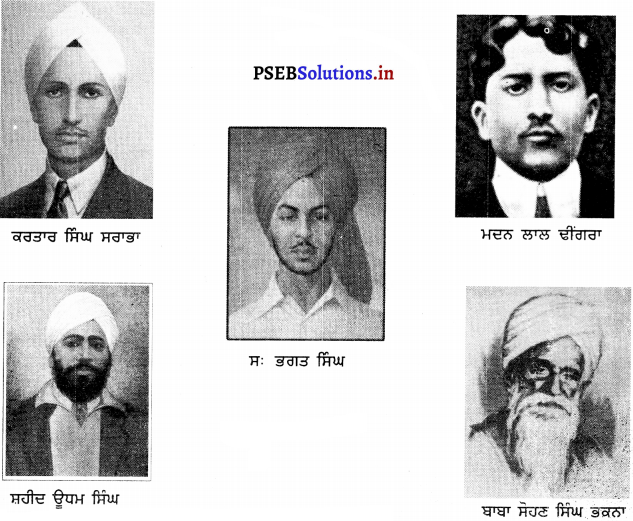
![]()
ਪ੍ਰਸ਼ਨ 2.
ਸ: ਕਰਤਾਰ ਸਿੰਘ ਦੀਆਂ ਸਰਗਰਮੀਆਂ ਬਾਰੇ ਨੋਟ ਲਿਖੋ।
ਉੱਤਰ :
(ਨੋਟ – ਦੇਖੋ – ਇਸ ਪਾਠ ਦੀ ਸੰਖੇਪ ਕਹਾਣੀ॥

